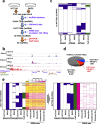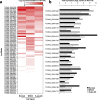A genomic screen for long noncoding RNA genes epigenetically silenced by aberrant DNA methylation in colorectal cancer
- PMID: 27215978
- PMCID: PMC4877637
- DOI: 10.1038/srep26699
A genomic screen for long noncoding RNA genes epigenetically silenced by aberrant DNA methylation in colorectal cancer
Abstract
Long noncoding RNAs (lncRNAs) have emerged as key components in multiple cellular processes, although their physiological and pathological functions are not fully understood. To identify cancer-related lncRNAs, we screened for those that are epigenetically silenced in colorectal cancer (CRC). Through a genome-wide analysis of histone modifications in CRC cells, we found that the transcription start sites (TSSs) of 1,027 lncRNA genes acquired trimethylation of histone H3 lysine 4 (H3K4me3) after DNA demethylation. Integrative analysis of chromatin signatures and the DNA methylome revealed that the promoter CpG islands (CGIs) of 66 lncRNA genes contained cancer-specific methylation. By validating the expression and methylation of lncRNA genes in CRC cells, we ultimately identified 20 lncRNAs, including ZNF582-AS1, as targets of epigenetic silencing in CRC. ZNF582-AS1 is frequently methylated in CRC cell lines (87.5%), primary CRCs (77.2%), colorectal adenomas (44.7%) and advanced adenomas (87.8%), suggesting that this methylation is an early event during colorectal tumorigenesis. Methylation of ZNF582-AS1 is associated with poor survival of CRC patients, and ectopic expression of ZNF582-AS1 suppressed colony formation by CRC cells. Our findings offer insight into the association between epigenetic alterations and lncRNA dysregulation in cancer and suggest that ZNF582-AS1 may be a novel tumor-suppressive lncRNA.
Conflict of interest statement
The authors declare no competing financial interests.
Figures







Similar articles
-
Comprehensive analysis of epigenetic pattern of long noncoding RNA loci in colorectal cancer.Gene. 2016 Dec 20;595(1):9-17. doi: 10.1016/j.gene.2016.09.020. Epub 2016 Sep 15. Gene. 2016. PMID: 27642123
-
Genome-wide screening for differentially methylated long noncoding RNAs identifies LIFR-AS1 as an epigenetically regulated lncRNA that inhibits the progression of colorectal cancer.Clin Epigenetics. 2022 Oct 31;14(1):138. doi: 10.1186/s13148-022-01361-0. Clin Epigenetics. 2022. PMID: 36316703 Free PMC article.
-
LncRNA SATB2-AS1 inhibits tumor metastasis and affects the tumor immune cell microenvironment in colorectal cancer by regulating SATB2.Mol Cancer. 2019 Sep 6;18(1):135. doi: 10.1186/s12943-019-1063-6. Mol Cancer. 2019. PMID: 31492160 Free PMC article.
-
MicroRNA Methylation in Colorectal Cancer.Adv Exp Med Biol. 2016;937:109-22. doi: 10.1007/978-3-319-42059-2_6. Adv Exp Med Biol. 2016. PMID: 27573897 Review.
-
Long noncoding RNAs: novel players in colorectal cancer.Cancer Lett. 2015 May 28;361(1):13-21. doi: 10.1016/j.canlet.2015.03.002. Epub 2015 Mar 6. Cancer Lett. 2015. PMID: 25754818 Review.
Cited by
-
Upregulation of long noncoding RNA TUG1 promotes cervical cancer cell proliferation and migration.Cancer Med. 2017 Feb;6(2):471-482. doi: 10.1002/cam4.994. Epub 2017 Jan 15. Cancer Med. 2017. PMID: 28088836 Free PMC article.
-
Abnormal methylation mediated upregulation of LINC00857 boosts malignant progression of lung adenocarcinoma by modulating the miR-486-5p/NEK2 axis.Clin Respir J. 2024 May;18(5):e13765. doi: 10.1111/crj.13765. Clin Respir J. 2024. PMID: 38721812 Free PMC article.
-
Long non-coding RNA levels can be modulated by 5-azacytidine in Schistosoma mansoni.Sci Rep. 2020 Dec 9;10(1):21565. doi: 10.1038/s41598-020-78669-5. Sci Rep. 2020. PMID: 33299037 Free PMC article.
-
LncRNA ZNF582-AS1 Expression and Methylation in Breast Cancer and Its Biological and Clinical Implications.Cancers (Basel). 2022 Jun 4;14(11):2788. doi: 10.3390/cancers14112788. Cancers (Basel). 2022. PMID: 35681777 Free PMC article.
-
Comparing progression molecular mechanisms between lung adenocarcinoma and lung squamous cell carcinoma based on genetic and epigenetic networks: big data mining and genome-wide systems identification.Oncotarget. 2019 Jun 4;10(38):3760-3806. doi: 10.18632/oncotarget.26940. eCollection 2019 Jun 4. Oncotarget. 2019. PMID: 31217907 Free PMC article.
References
Publication types
MeSH terms
Substances
LinkOut - more resources
Full Text Sources
Other Literature Sources
Medical

